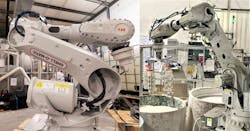Franklin Bronze Precision Components is one of many manufacturers taking advantage of the opportunity to add the next generation of automation upgrades. Franklin Bronze has been on the forefront of automation since it introduced robots to its investment casting manufacturing processes in early 2005, and it continues to stay ahead with its latest introduction of new robotic technologies in its shell room.
Franklin Bronze Precision Components manufactures investment castings for glass container, pumps and valves, steel, automotive and food processing. Franklin Bronze provides products supported by technical expertise, in-house tooling and machining and automated processing. Located in Franklin, Pennsylvania, the manufacturer prides itself on speed to market and close collaboration with customers.
Franklin Bronze kicked off 2020 by upgrading the robotic arm and supervisory system in Shell Room 2. Installed by Shell-O-Matic, the robot arm was replaced with a new state-of-the-art one. Additionally, the supervisory control and data acquisition (SCADA) system, the operating platform, was upgraded to the newest version available. The upgrade allows for unlimited future growth and flexibility of Franklin Bronze’s investment cast shell room processes. The new operating system is designed to provide more accurate identification of molds and parts with less manual manipulation, essentially allowing for quality protection of products during the production process.
[pullquote]With this investment, Franklin Bronze implements Industry 4.0 technology with the installation of forward-looking automatic laser level adjustment, a technique brand new to robots and automated investment casting foundries.
“The new robot arm, with the laser level adjustment, can automatically and instantly determine the level of slurry tank and will stop if it’s too low,” explains Chris Barber, operations manager at Franklin Bronze (www.franklinbronze.com). "It senses the levels on its own and is a great example of Industrial Internet of Things (IIoT) with its interconnected sensors triggering the robot to respond. It's a game changer and keeps us way ahead of the competition."
In addition to the laser level adjustment, radio-frequency-identification (RFID) scanning was also installed. RFID scanning equips the robot to recognize and group like products together for the most efficient mold shelling process in the shortest runtime necessary.
Mike Bacidore is the editor in chief for Control Design magazine. He is an award-winning columnist, earning a Gold Regional Award and a Silver National Award from the American Society of Business Publication Editors. Email him at [email protected].
About the Author
Mike Bacidore
Editor in Chief
Mike Bacidore is chief editor of Control Design and has been an integral part of the Endeavor Business Media editorial team since 2007. Previously, he was editorial director at Hughes Communications and a portfolio manager of the human resources and labor law areas at Wolters Kluwer. Bacidore holds a BA from the University of Illinois and an MBA from Lake Forest Graduate School of Management. He is an award-winning columnist, earning multiple regional and national awards from the American Society of Business Publication Editors. He may be reached at [email protected]

Leaders relevant to this article:


